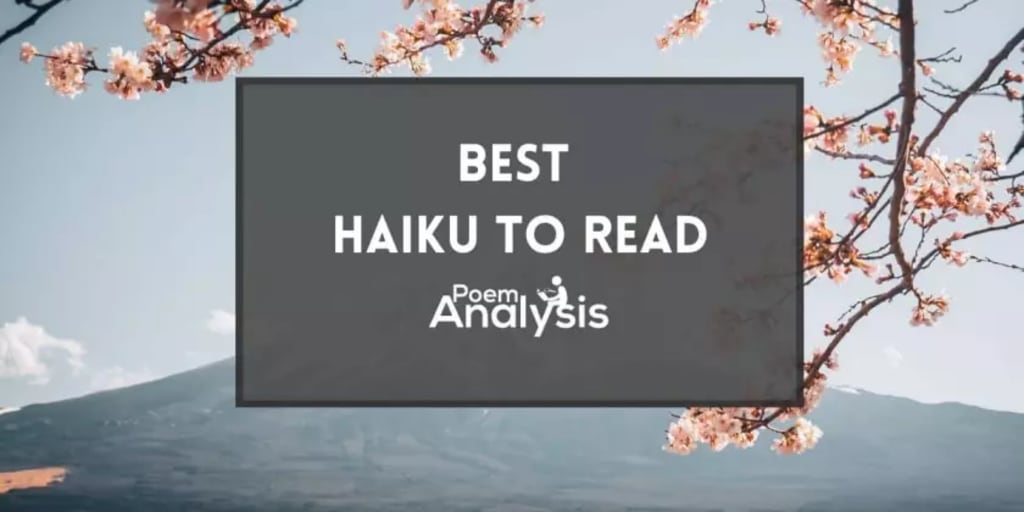How To Analyze A Haiku And Haiku Structure
Know the sound structure of Haiku

Haiku is a traditional form of Japanese poetry that has been enjoyed and practiced for centuries. It is a concise, yet powerful form of poetry that evokes emotions and creates vivid images through the use of language and imagery. Haiku is an excellent form of poetry for those looking to develop their analytical skills and gain a deeper appreciation for poetry. In this guide, we will explore the steps for analyzing a Haiku, so that you can better understand this beautiful form of poetry.
Identify the Season Word (Kigo):
The first step in analyzing a Haiku is to identify the season word or reference to the season, known as the Kigo. Kigo is an integral part of Haiku and provides insight into the poet's mood and the atmosphere of the poem. Haiku often references the seasons, such as spring, summer, autumn, and winter, but can also reference other aspects of nature such as the moon, the sun, and the stars. By identifying the Kigo, you can better understand the context and mood of the poem.
Break down the structure:
A traditional Haiku consists of 17 syllables, divided into three lines with a 5-7-5 syllable structure. This structure is an essential part of Haiku, and it helps to create a sense of balance and harmony in the poem. By breaking down the structure of the Haiku, you can better understand how the poet has used language and imagery to create a specific mood and atmosphere.
Focus on the images:
Haiku is all about creating a vivid image in the reader's mind. The images described in Haiku can range from the natural world to the human experience, and they are used to evoke emotions and create a connection between the reader and the poem. By focusing on the images in the Haiku, you can better understand the poet's intention and the meaning behind the poem.
Look for a "Cut" or "Shift":
Haiku often contains a "cut" or a "shift" in the middle, separating the first and second lines. The cut marks a change in direction or a shift in focus, creating a new perspective on the subject matter. The cut is a crucial part of Haiku, and it helps to create a sense of movement and progression in the poem. By looking for the cut or shift, you can better understand the development of the poem and the emotions it evokes.
Interpret the emotions:
Haiku is known for evoking emotions, often depicting a moment in time, a feeling, or a season. The language and imagery used in Haiku are carefully chosen to create a specific mood and atmosphere, and it is up to the reader to interpret the emotions depicted in the poem. By analyzing the language and imagery used in the Haiku, you can better understand the emotions the poet is trying to convey.
Consider the cultural context:
Haiku originated in Japan, and traditional Haiku often reflects the culture and nature of Japan. Understanding the cultural context can provide a deeper appreciation for the poem, as it allows you to understand the references and imagery used in the poem. By considering the cultural context of the Haiku, you can better understand the poem and its place in Japanese culture and tradition.
In conclusion, analyzing a Haiku can be a rewarding experience that allows you to gain a deeper appreciation for this beautiful form of poetry. By following these steps, you can analyze a Haiku and gain a deeper understanding of its meaning and the emotions it evokes. Whether you are a beginner or an experienced reader, Haiku is a form of poetry that will continue to captivate and inspire you for years to come.
Haiku Structure
Haiku is a traditional form of Japanese poetry that is known for its simplicity and beauty. It consists of only 17 syllables, divided into three lines with a 5-7-5 syllable structure. The structure of a Haiku is crucial to its success, as it helps to create a sense of balance and harmony in the poem. In this guide, we will explore the Haiku structure and how it is used to create powerful and evocative poems.
Syllable structure:
A traditional Haiku consists of 17 syllables, divided into three lines with a 5-7-5 syllable structure. This structure is an essential part of Haiku, and it helps to create a sense of balance and harmony in the poem. The first line is composed of five syllables, the second line is composed of seven syllables, and the third line is composed of five syllables.
Focus on nature:
Haiku is often focused on nature, and it is a way to capture the beauty and essence of the natural world. The focus on nature is reflected in the imagery and language used in Haiku, and it helps to create a connection between the reader and the poem.
Use of seasonal references:
Haiku often contains a reference to the season, known as the Kigo. The reference to the season is an integral part of Haiku, and it provides insight into the poet's mood and the atmosphere of the poem. The use of seasonal references helps to create a sense of time and place in the poem.
Simple language:
Haiku is known for its simplicity, and it uses straightforward and uncomplicated language to evoke emotions and create vivid images. The language used in Haiku is carefully chosen to create a specific mood and atmosphere, and it is designed to be accessible and easy to understand for readers of all ages and backgrounds.
Focus on a moment in time:
Haiku is often focused on capturing a moment in time, and it is designed to evoke emotions and create a connection between the reader and the poem. The focus on a moment in time is reflected in the imagery and language used in Haiku, and it helps to create a sense of progression and movement in the poem.
In conclusion, the structure of Haiku is an essential part of this traditional form of Japanese poetry, and it helps to create a sense of balance and harmony in the poem. By following the Haiku structure, you can create powerful and evocative poems that will captivate and inspire readers for years to come.
About the Creator
Enjoyed the story? Support the Creator.
Subscribe for free to receive all their stories in your feed. You could also pledge your support or give them a one-off tip, letting them know you appreciate their work.
Reader insights
Nice work
Very well written. Keep up the good work!
Top insights
Excellent storytelling
Original narrative & well developed characters
Expert insights and opinions
Arguments were carefully researched and presented
Heartfelt and relatable
The story invoked strong personal emotions
On-point and relevant
Writing reflected the title & theme





Comments
There are no comments for this story
Be the first to respond and start the conversation.